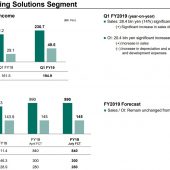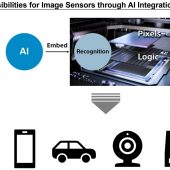
A few weeks ago we reported on an activist investor wanting Sony to spin off their semiconductors division. It looks like Sony responded to the activist investor by renaming the semiconductors business division and merging it more tightly into their other operations according to Image Sensor Resource Worlds excerpts below from the earnings call transcript below:
Semiconductors segment to Imaging & Sensing Solutions Name Change
Sony official earnings call transcript explains the name change. The explanation sounds like a reply on the spin-off proposals:
• From this quarter, we have changed the name of the Semiconductors segment to Imaging & Sensing Solutions (“I&SS”).
• Now I will explain the background and reasoning behind the change in name of the segment.
• The portion of Semiconductors segment revenue that comes from image sensors has been increasing every year, is expected to be approximately 85% of the segment this fiscal year and is expected to increase even more going forward.
• Image sensors are hybrids between analog and digital semiconductors, and, in terms of technology and business model, differ from logic LSI and memory, which most people think of when they hear the word semiconductors.
• Compared with logic LSI and memory, which require frequent capacity upgrades to maintain competitiveness due to quickly evolving process miniaturization, image sensors do not require regular, large capital investments because products can be differentiated through improvements in functionality and the addition of new features without having to upgrade production capacity.
• Moreover, since the image sensors business is focused on custom products that are differentiated through features and functionality, and because we have expanded our customer base the last several years and obtained a large share of the market, we have established a business model that experiences less impact from fluctuations in the market known as the silicon cycle.
• Over the last 10 years, we have achieved an extremely high level of compound annual sales growth at 17%, primarily from smartphone applications, and we have made significant investments to increase capacity as a result. However, we expect the investment requirements of this business to decrease significantly as the acute increase in demand transitions to a milder growth trajectory.
• The strategy for future growth in the I&SS segment is to develop AI sensors which make our sensors more intelligent by combining artificial intelligence with the sensors themselves.
• Development of these sensors will require us to leverage not only the strength of the hardware technology in the I&SS segment, such as the stacking of sensors on logic and copper-to-copper connections, but also the AI technology and diverse application technology in other parts of Sony, so our efforts in this area will span the entire Sony Group.
• We think that AI and sensing will be used across a wide range of applications such as autonomous driving, IoT, games and immersive entertainment. As such, we think there is a possibility that image sensors will evolve from the hardware they are today to solutions and platforms as visual data and sensing information is processed in a sophisticated manner inside sensors.
• The image sensor business is important because it is one of the pillars of the growth strategy of the Sony Group. We changed the name of the segment this time to assist your understanding of the characteristics and future strategy of this business, which I just explained.
• FY19 Q1 sales increased 14% year-on-year to 230.7 billion yen and operating income increased 20.4 billion yen to 49.5 billion yen, primarily due to a significant increase in image sensor sales for mobile devices.
• Demand for our image sensors continues to be strong and our market share of image sensors for mid-range and high-end models of major smartphone makers remains high, due to adoption of multiple sensors per camera and growing demand for high value-added sensors made using large die-sizes.
• We are currently utilizing 100% of our internal capacity.
• However, concerns about the impact of trade issues in the second half of the fiscal year remain. We have already been conservative when forecasting the impact of these issues, but, because we want to evaluate the risks over the course of the first half of the fiscal year, we have made no changes to our April forecast.
via Sony.net


